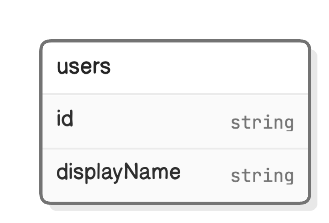Syntax
Entities
Entities correspond to database tables or similar. Entities contain attributes.
Entity definitions consist of a name followed by { }. For example, users is the name of the below entity and it contains attributes id and displayName.
users {
id string
displayName string
}

It is possible for entities to contain nothing like the below.
users { }

Entity names are required to be unique.
Attributes
Attributes correspond to database table columns or similar.
Attribute definitions occur within an entity definition. They consist of a name, type (optional), and metadata (optional) delimited by the space character. Here is an example:
users {
id string pk
}

Outside of a definition (e.g. in a relationship statement), attributes are referred to following the entity that they belong to, separated by a .. Here is an example:
users.teamId > teams.id

It is possible to define an attribute and create a relationship in the same line by using a relationship statement directly inside the table definition. Here is an example:
users {
teamId < teams.id
}

Properties
Properties are key-value pairs enclosed in [ ] brackets that can be appended to entity definitions. Properties are optional.
It is possible to set multiple properties like shown below:
users [icon: user, color: blue] {
teamId < teams.id
}

Here are the properties that are allowed:
| Property | Description | Value | Default value |
|---|---|---|---|
icon | Attached icons | Icon names (e.g. aws-ec2). See Icons page for full list. | |
color | Stroke and fill color, when possible | Color name (e.g. blue) or hex code (e.g. #000000) | |
colorMode | Fill color lightness | pastel, bold, outline | pastel |
styleMode | Embellishments | shadow, plain, watercolor | shadow |
typeface | Text typeface | rough, clean, mono | rough |
Here are the lists of icon names:
Refer to Styling for more details and examples on the colorMode, styleMode, and typeface properties.
Relationships
Relationships show the attribute-level relations between entities.
Here is an example:
users.teamId > teams.id

It is possible to show omit the attribute-level and simply show entity-level relations like this:
users > teams

The type of connecting line represents the cardinality between the two entities. Here are the types:
| Connector | Syntax | Description |
|---|---|---|
< |
One-to-many | |
> |
Many-to-one | |
- |
One-to-one | |
<> |
Many-to-many |
If a relationship statement contains a name that has not been previously defined as an entity or attribute, an entity or attribute with that name will be created.
Icons
Here's a list of all the icons you can use with diagram-as-code.
Escape string
Certain reserved characters are not allowed in entity or attribute names. However, you can still use these characters by wrapping the entire entity or attribute name in quotes " ".
"CI/CD" [icon: gear] {
id string pk
}
Styling
Styles can be applied at the diagram level. Below is an overview of the options and syntax. Refer to Styling for more details and examples.
| Property | Values | Default value | Syntax example |
|---|---|---|---|
colorMode | pastel, bold, outline | pastel | colorMode bold |
styleMode | shadow, plain, watercolor | shadow | styleMode shadow |
typeface | rough, clean, mono | rough | typeface clean |
Updated 2 days ago